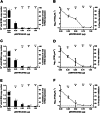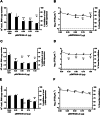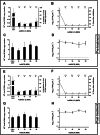Multi-targeted gene silencing strategies inhibit replication of Canine morbillivirus
- PMID: 33213424
- PMCID: PMC7676405
- DOI: 10.1186/s12917-020-02671-2
Multi-targeted gene silencing strategies inhibit replication of Canine morbillivirus
Abstract
Background: Canine morbilivirus (canine distemper virus, CDV) is a highly contagious pathogen associated with high morbidity and mortality in susceptible carnivores. Although there are CDV vaccines available, the disease poses a huge threat to dogs and wildlife hosts due to vaccine failures and lack of effective treatment. Thus, the development of therapeutics is an urgent need to achieve rapid outbreak control and reduce mortality in target species. Gene silencing by RNA interference has emerged as a promising therapeutic approach against different human and animal viruses. In this study, plasmid-based short hairpin RNAs (shRNAs) against three different regions in either CDV nucleoprotein (N), or large polymerase (L) genes and recombinant adenovirus-expressing N-specific multi-shRNAs were generated. Viral cytopathic effect, virus titration, plaque-forming unit reduction, and real-time quantitative RT-PCR analysis were used to check the efficiency of constructs against CDV.
Results: In CDV-infected VerodogSLAM cells, shRNA-expressing plasmids targeting the N gene markedly inhibited the CDV replication in a dose-dependent manner, with viral genomes and titers being decreased by over 99%. Transfection of plasmid-based shRNAs against the L gene displayed weaker inhibition of viral RNA level and virus yield as compared to CDV N shRNAs. A combination of shRNAs targeting three sites in the N gene considerably reduced CDV RNA and viral titers, but their effect was not synergistic. Recombinant adenovirus-expressing multiple shRNAs against CDV N gene achieved a highly efficient knockdown of CDV N mRNAs and successful inhibition of CDV replication.
Conclusions: We found that this strategy had strong silencing effects on CDV replication in vitro. Our findings indicate that the delivery of shRNAs using plasmid or adenovirus vectors potently inhibits CDV replication and provides a basis for the development of therapeutic strategies for clinical trials.
Keywords: Adenoviral vector; Gene therapy; Morbillivirus; RNA interference.
Conflict of interest statement
The authors declare that they have no competing interests.
Figures







Similar articles
-
A Single Oral Immunization with Replication-Competent Adenovirus-Vectored Vaccine Induces a Neutralizing Antibody Response in Mice against Canine Distemper Virus.Viruses. 2022 Aug 23;14(9):1847. doi: 10.3390/v14091847. Viruses. 2022. PMID: 36146652 Free PMC article.
-
Persistent and Severe Viral Replication in PBMCs with Moderate Immunosuppression Served an Alternative Novel Pathogenic Mechanism for Canine Morbillivirus.Microbiol Spectr. 2023 Feb 14;11(1):e0406022. doi: 10.1128/spectrum.04060-22. Epub 2022 Dec 19. Microbiol Spectr. 2023. PMID: 36533959 Free PMC article.
-
The recombinant EHV-1 vector producing CDV hemagglutinin as potential vaccine against canine distemper.Microb Pathog. 2017 Oct;111:388-394. doi: 10.1016/j.micpath.2017.09.006. Epub 2017 Sep 6. Microb Pathog. 2017. PMID: 28888886
-
Canine and Phocine Distemper Viruses: Global Spread and Genetic Basis of Jumping Species Barriers.Viruses. 2019 Oct 14;11(10):944. doi: 10.3390/v11100944. Viruses. 2019. PMID: 31615092 Free PMC article. Review.
-
Evolution and Interspecies Transmission of Canine Distemper Virus-An Outlook of the Diverse Evolutionary Landscapes of a Multi-Host Virus.Viruses. 2019 Jun 26;11(7):582. doi: 10.3390/v11070582. Viruses. 2019. PMID: 31247987 Free PMC article. Review.
Cited by
-
Antiviral activity of ouabain against a Brazilian Zika virus strain.Sci Rep. 2022 Jul 23;12(1):12598. doi: 10.1038/s41598-022-14243-5. Sci Rep. 2022. PMID: 35871157 Free PMC article.
-
Development of HEK293T-produced recombinant receptor-Fc proteins as potential candidates against canine distemper virus.Front Vet Sci. 2023 May 5;10:1180673. doi: 10.3389/fvets.2023.1180673. eCollection 2023. Front Vet Sci. 2023. PMID: 37215466 Free PMC article.
References
-
- Appel MJG, Summers BA. Canine distemper: current status. In: Recent advances in infectious diseases. In: Carmichael, L.E, editor. Recent advances in canine infectious diseases. Ithaca: International Veterinary Information Service; 1999.
-
- Nagao Y, Nishio Y, Shiomoda H, Tamaru S, Shimojima M, Goto M, et al. An outbreak of canine distemper virus in tigers (Panthera tigris): possible transmission from wild animals to zoo animals. J Vet Med Sci. 2011;74:699–705. - PubMed
-
- Origgi FC, Plattet P, Sattler U, Robert N, Casaubon J, Mavrot F, et al. Emergence of canine distemper virus strains with modified molecular signature and enhanced neuronal tropism leading to high mortality in wild carnivores. Vet Pathol. 2012;49:913–929. - PubMed
MeSH terms
Substances
Grants and funding
LinkOut - more resources
Full Text Sources

